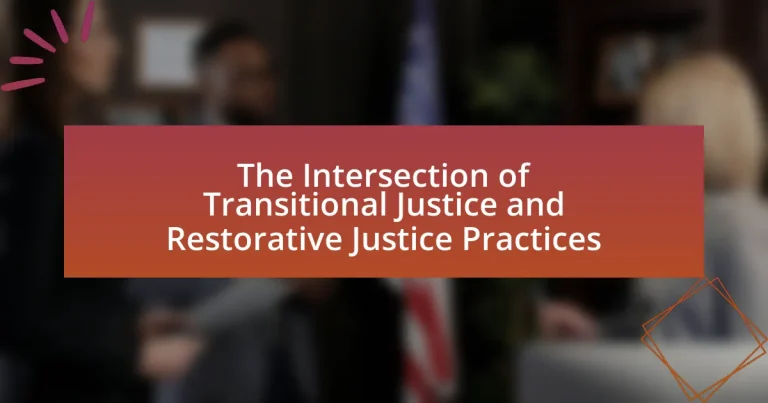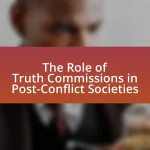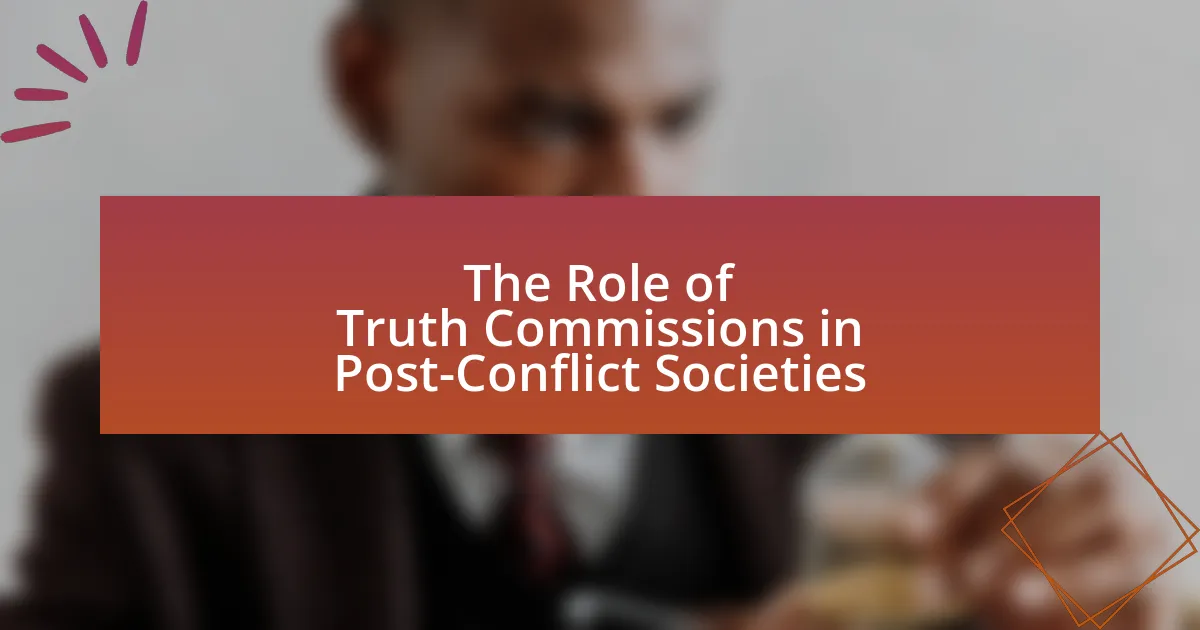The article examines the intersection of transitional justice and restorative justice practices, highlighting their shared objectives of addressing past injustices and fostering community healing. It outlines the differences and overlaps between the two approaches, emphasizing key principles such as accountability, truth-seeking, and community involvement. The discussion includes real-world examples, such as South Africa’s Truth and Reconciliation Commission and Rwanda’s Gacaca courts, illustrating successful integrations of both practices. Additionally, the article addresses challenges, best practices for community participation, and the implications for future justice initiatives, providing a comprehensive overview of how these frameworks can enhance justice outcomes in post-conflict societies.
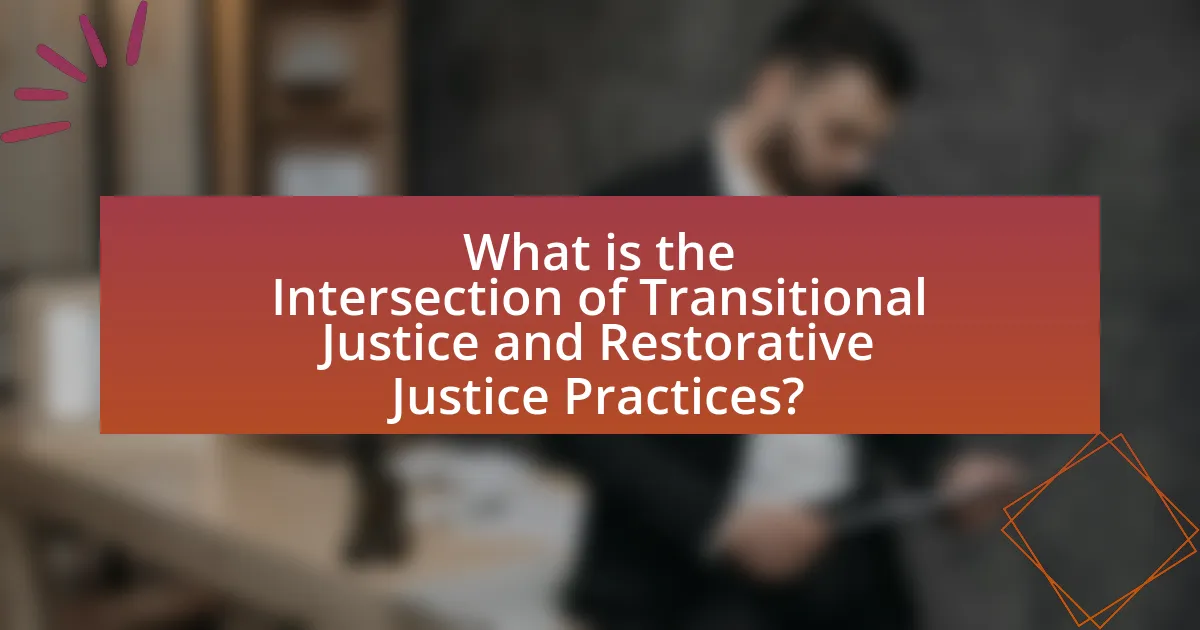
What is the Intersection of Transitional Justice and Restorative Justice Practices?
The intersection of transitional justice and restorative justice practices lies in their shared goal of addressing past injustices and fostering healing within communities. Transitional justice focuses on the measures implemented in societies transitioning from conflict or authoritarian rule to democracy, aiming to hold perpetrators accountable and provide redress to victims. Restorative justice, on the other hand, emphasizes repairing the harm caused by criminal behavior through inclusive processes that engage victims, offenders, and the community. Both approaches prioritize victim participation and aim to restore relationships, highlighting the importance of truth-telling and reconciliation. For instance, truth commissions, often a component of transitional justice, can incorporate restorative justice principles by allowing victims to share their experiences and seek acknowledgment from offenders, thereby promoting societal healing and preventing future violence.
How do Transitional Justice and Restorative Justice differ and overlap?
Transitional Justice and Restorative Justice differ primarily in their scope and objectives, yet they overlap in their focus on healing and accountability. Transitional Justice addresses large-scale human rights violations during periods of political transition, aiming to establish accountability, truth, and reparations for victims, as seen in post-apartheid South Africa’s Truth and Reconciliation Commission. In contrast, Restorative Justice emphasizes repairing harm caused by criminal behavior on an individual level, fostering dialogue between victims and offenders to achieve reconciliation, exemplified by community-based restorative practices in various jurisdictions. Both approaches share a commitment to restoring relationships and promoting social cohesion, but they operate at different levels—Transitional Justice at a societal level and Restorative Justice at an individual or community level.
What are the key principles of Transitional Justice?
The key principles of Transitional Justice include accountability, truth-seeking, reparations, and institutional reform. Accountability ensures that perpetrators of human rights violations are held responsible, which is essential for restoring public trust. Truth-seeking mechanisms, such as truth commissions, aim to uncover the facts about past abuses, providing a historical record and promoting healing. Reparations involve compensating victims for their suffering, acknowledging their experiences, and facilitating their reintegration into society. Institutional reform focuses on transforming state institutions to prevent future violations, ensuring that justice systems are fair and effective. These principles are foundational in addressing legacies of violence and fostering reconciliation in post-conflict societies.
What are the fundamental concepts of Restorative Justice?
The fundamental concepts of Restorative Justice include accountability, healing, and community involvement. Accountability emphasizes the responsibility of the offender to acknowledge their actions and the harm caused, fostering a sense of ownership over their behavior. Healing focuses on the restoration of relationships and emotional well-being for both victims and offenders, aiming to repair the damage done rather than simply punishing the offender. Community involvement encourages collective participation in the justice process, allowing stakeholders to engage in dialogue and contribute to solutions that address the needs of all parties affected by the crime. These concepts are supported by various studies, such as those conducted by the Center for Justice and Reconciliation, which highlight the effectiveness of restorative practices in reducing recidivism and promoting victim satisfaction.
Why is the intersection of these two practices significant?
The intersection of transitional justice and restorative justice practices is significant because it promotes healing and reconciliation in societies recovering from conflict or systemic injustice. This intersection allows for a comprehensive approach that addresses both the need for accountability and the restoration of relationships among affected communities. Research indicates that integrating restorative justice principles into transitional justice mechanisms can enhance victim participation and satisfaction, as seen in the Truth and Reconciliation Commission in South Africa, which facilitated dialogue and acknowledgment of past harms while fostering community healing.
How can combining these approaches enhance justice outcomes?
Combining transitional justice and restorative justice practices can enhance justice outcomes by fostering accountability while promoting healing within communities. Transitional justice focuses on addressing past human rights violations through legal and institutional reforms, while restorative justice emphasizes repairing harm through dialogue and reconciliation. When these approaches are integrated, they create a comprehensive framework that not only seeks to hold perpetrators accountable but also prioritizes the needs and voices of victims. For instance, countries like South Africa have successfully utilized this combination through truth commissions that allow victims to share their experiences, leading to societal healing and a more robust understanding of justice. This dual approach can result in more sustainable peace and social cohesion, as it addresses both the legal and emotional dimensions of justice.
What challenges arise at the intersection of these practices?
Challenges at the intersection of transitional justice and restorative justice practices include reconciling differing objectives, balancing accountability with healing, and addressing power imbalances. Transitional justice primarily focuses on addressing past human rights violations and ensuring accountability, while restorative justice emphasizes healing and reconciliation among victims and offenders. This divergence can lead to conflicts in prioritizing justice versus restoration. Additionally, achieving a balance between holding perpetrators accountable and fostering an environment conducive to healing can complicate the implementation of these practices. Power imbalances, often present in contexts of conflict or oppression, can further hinder equitable participation in restorative processes, potentially marginalizing victims’ voices and undermining the effectiveness of both approaches.
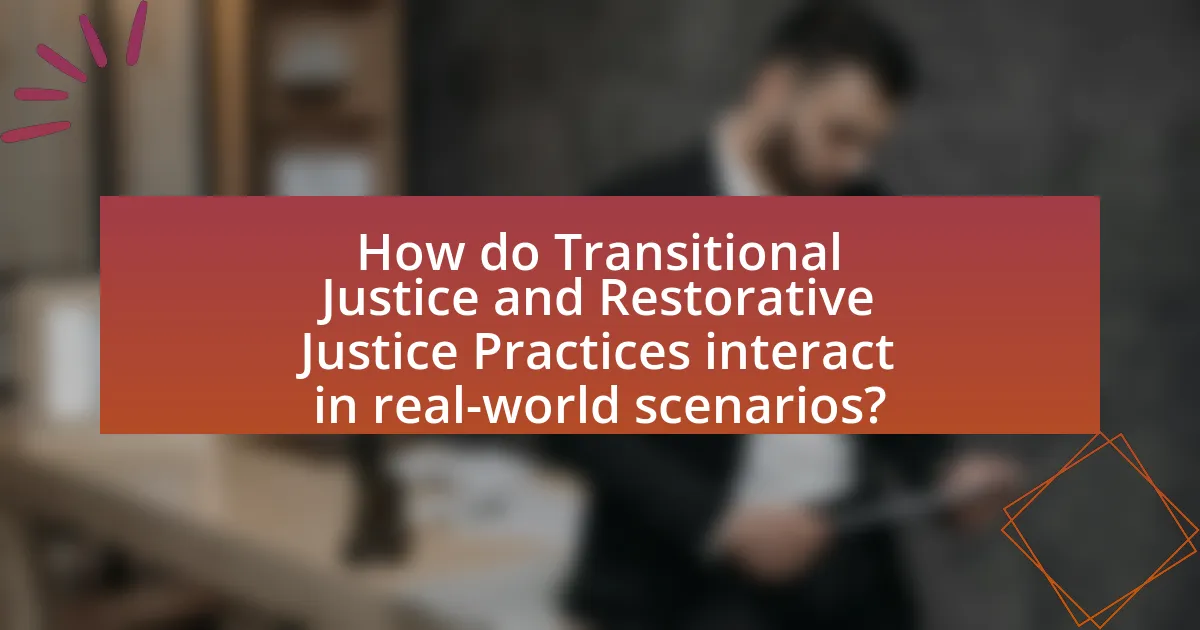
How do Transitional Justice and Restorative Justice Practices interact in real-world scenarios?
Transitional Justice and Restorative Justice Practices interact by complementing each other in addressing the aftermath of conflict and human rights violations. Transitional Justice focuses on accountability, truth-seeking, and reparations, while Restorative Justice emphasizes healing, reconciliation, and community involvement. For instance, in South Africa, the Truth and Reconciliation Commission combined elements of both approaches by allowing victims to share their experiences and perpetrators to confess their crimes, fostering societal healing while also promoting accountability. This interaction demonstrates how integrating both frameworks can lead to more comprehensive solutions for post-conflict societies, as evidenced by the positive outcomes in community rebuilding and social cohesion observed in various case studies.
What are some examples of successful integration of both practices?
Successful integration of transitional justice and restorative justice practices can be observed in South Africa’s Truth and Reconciliation Commission (TRC) and the Gacaca courts in Rwanda. The TRC facilitated a platform for victims and perpetrators to share their experiences, promoting healing and accountability after apartheid, while the Gacaca courts enabled community-based trials for genocide cases, emphasizing reconciliation and community involvement. Both examples demonstrate how integrating these practices can foster societal healing and restore relationships in post-conflict settings.
How did South Africa’s Truth and Reconciliation Commission exemplify this intersection?
South Africa’s Truth and Reconciliation Commission (TRC) exemplified the intersection of transitional justice and restorative justice practices by promoting healing and accountability following apartheid. The TRC facilitated public hearings where victims and perpetrators could share their experiences, fostering a collective understanding of past injustices. This approach emphasized restorative justice principles, such as reconciliation and community healing, while also addressing the need for accountability through its recommendations for reparations and legal actions against human rights violators. The TRC’s framework, which included testimonies from over 21,000 individuals and the documentation of human rights abuses, demonstrated how transitional justice can incorporate restorative elements to build a more just society.
What lessons can be learned from the experiences of other countries?
Countries that have implemented transitional justice and restorative justice practices demonstrate that inclusive dialogue and community involvement are crucial for healing and reconciliation. For instance, South Africa’s Truth and Reconciliation Commission (TRC) highlighted the importance of acknowledging past injustices to foster national unity, as it allowed victims to share their stories and perpetrators to confess, promoting collective healing. Additionally, Rwanda’s Gacaca courts showcased the effectiveness of local community involvement in addressing crimes from the genocide, emphasizing restorative approaches that prioritize reconciliation over retribution. These examples illustrate that successful transitional justice frameworks often rely on local context, community engagement, and a focus on healing rather than punishment, leading to more sustainable peace and social cohesion.
What role do community involvement and participation play?
Community involvement and participation play a crucial role in enhancing the effectiveness of transitional justice and restorative justice practices. Engaging communities fosters a sense of ownership and accountability, which is essential for the legitimacy and sustainability of justice processes. Research indicates that when communities actively participate, they contribute valuable local knowledge and perspectives that can inform justice mechanisms, making them more relevant and culturally appropriate. For instance, a study by the United Nations Development Programme highlights that inclusive approaches lead to higher rates of satisfaction and compliance with justice outcomes, as communities feel their voices are heard and respected.
How does community engagement influence the effectiveness of these practices?
Community engagement significantly enhances the effectiveness of transitional justice and restorative justice practices by fostering trust and collaboration among stakeholders. When communities actively participate in these processes, they contribute local knowledge and perspectives that ensure the practices are culturally relevant and tailored to specific needs. Research indicates that inclusive community engagement leads to higher rates of compliance and satisfaction with justice outcomes, as seen in the case of South Africa’s Truth and Reconciliation Commission, where community involvement was crucial in addressing historical grievances and promoting healing. This active participation not only legitimizes the processes but also empowers communities, making them integral to the success of justice initiatives.
What are the best practices for fostering community participation?
The best practices for fostering community participation include creating inclusive platforms for dialogue, ensuring transparency in decision-making, and providing education on relevant issues. Inclusive platforms allow diverse community voices to be heard, which enhances trust and engagement. Transparency in decision-making processes builds credibility and encourages community members to contribute actively. Education empowers individuals with knowledge about their rights and the justice processes, facilitating informed participation. Research indicates that communities with higher levels of engagement in transitional justice processes report greater satisfaction with outcomes and increased social cohesion, as evidenced by studies conducted by the United Nations Development Programme.
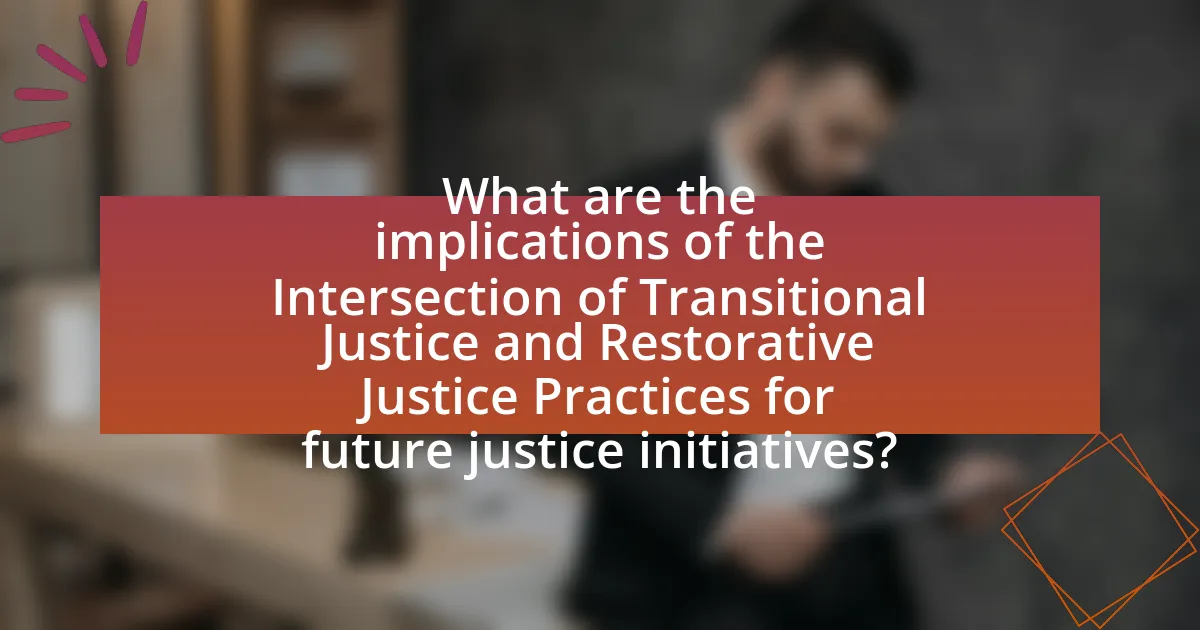
What are the implications of the Intersection of Transitional Justice and Restorative Justice Practices for future justice initiatives?
The intersection of transitional justice and restorative justice practices implies a more holistic approach to addressing past injustices, fostering reconciliation, and promoting healing in affected communities. This integration allows for a focus on individual and collective accountability while prioritizing the needs and voices of victims, which can lead to more sustainable peace and social cohesion. Evidence from various post-conflict societies, such as South Africa and Rwanda, demonstrates that combining these frameworks can enhance community engagement and empower victims, ultimately contributing to more effective justice initiatives that address both legal and social dimensions of justice.
How can policymakers leverage this intersection for better outcomes?
Policymakers can leverage the intersection of transitional justice and restorative justice practices by integrating community-based approaches that prioritize healing and accountability. This integration fosters a more inclusive dialogue among affected communities, which can lead to sustainable peace and reconciliation. For instance, countries like South Africa have successfully utilized truth commissions that incorporate restorative justice principles, allowing victims to share their experiences while promoting societal healing. Research indicates that such approaches can reduce recidivism and enhance community trust in justice systems, as evidenced by studies showing that restorative practices lead to higher satisfaction rates among victims and offenders alike.
What strategies can be implemented to promote collaboration between these practices?
To promote collaboration between transitional justice and restorative justice practices, establishing interdisciplinary forums for dialogue is essential. These forums can facilitate knowledge sharing, allowing practitioners from both fields to discuss methodologies, share case studies, and identify common goals. Research indicates that collaborative training programs enhance understanding and integration of both practices, leading to more effective outcomes in addressing past injustices. For instance, the United Nations has emphasized the importance of integrating restorative approaches in transitional justice mechanisms, highlighting successful examples from countries like South Africa and Rwanda where such collaboration has led to improved reconciliation efforts.
How can training and education enhance understanding of both approaches?
Training and education can enhance understanding of both transitional justice and restorative justice practices by providing comprehensive frameworks and methodologies that clarify their principles and applications. Structured learning environments, such as workshops and academic courses, facilitate critical discussions and case studies that illustrate the nuances of each approach, enabling participants to grasp their distinct yet complementary roles in addressing justice and reconciliation. Research indicates that educational programs focused on these topics improve practitioners’ ability to implement effective strategies, as evidenced by a study published in the Journal of Peace Research, which found that trained professionals are more adept at navigating complex social dynamics in post-conflict settings.
What are the common pitfalls to avoid in integrating these practices?
Common pitfalls to avoid in integrating transitional justice and restorative justice practices include a lack of stakeholder engagement, insufficient understanding of cultural contexts, and inadequate training for facilitators. Engaging stakeholders ensures that the needs and perspectives of affected communities are considered, which is crucial for the legitimacy of the process. A failure to understand cultural contexts can lead to practices that are inappropriate or ineffective, undermining the goals of both justice frameworks. Additionally, facilitators must be adequately trained to navigate the complexities of these practices; without proper training, the processes may not achieve their intended outcomes, as evidenced by various case studies where poorly facilitated dialogues led to further conflict rather than resolution.
What are the risks of misapplying Transitional Justice principles in Restorative Justice contexts?
Misapplying Transitional Justice principles in Restorative Justice contexts can lead to several significant risks, including undermining the legitimacy of restorative processes and perpetuating cycles of violence. When Transitional Justice, which focuses on addressing past human rights violations and promoting accountability, is incorrectly applied, it may overshadow the community-oriented and healing aspects of Restorative Justice. This misalignment can alienate victims and communities, as the emphasis on punitive measures may conflict with the restorative goals of reconciliation and healing. Furthermore, the imposition of state-centric Transitional Justice frameworks can marginalize local practices and cultural contexts, leading to ineffective or harmful outcomes. Historical examples, such as the challenges faced in post-apartheid South Africa, illustrate how a rigid application of Transitional Justice can disrupt community cohesion and hinder genuine restorative efforts.
How can practitioners ensure ethical considerations are met in both practices?
Practitioners can ensure ethical considerations are met in both transitional justice and restorative justice practices by adhering to established ethical frameworks and guidelines that prioritize the rights and dignity of all individuals involved. This includes obtaining informed consent from participants, ensuring transparency in processes, and actively involving affected communities in decision-making. Research indicates that frameworks such as the United Nations Basic Principles and Guidelines on the Right to a Remedy and Reparation provide essential standards for ethical conduct in these practices, emphasizing accountability and victim participation. By integrating these principles, practitioners can create a more just and ethical environment that respects the needs and voices of all stakeholders.
